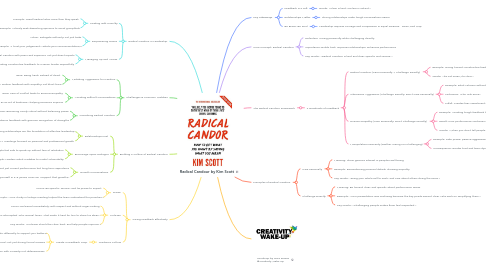
1. Radical Candour in Leadership
1.1. Leading with Humility
1.1.1. Principle: Great leaders listen more than they speak
1.1.2. Example: Actively seek dissenting opinions to avoid groupthink
1.2. Empowering Teams
1.2.1. Action: Delegate authority, not just tasks
1.2.2. Example: “I trust your judgement—what’s your recommendation?”
1.3. Managing Up and Across
1.3.1. Application: Use Radical Candour with peers and superiors, not just direct reports
1.3.2. Example: Providing constructive feedback to a senior leader respectfully
2. Challenges & Common Mistakes
2.1. Mistaking Aggression for Candour
2.1.1. Issue: Being harsh instead of direct
2.1.2. Fix: Deliver feedback with empathy, not blunt force
2.2. Avoiding Difficult Conversations
2.2.1. Issue: Fear of conflict leads to Ruinous Empathy
2.2.2. Fix: Reframe feedback as an act of kindness—helping someone improve
2.3. Overdoing Radical Candour
2.3.1. Issue: Becoming overly critical without balancing praise
2.3.2. Fix: Balance feedback with genuine recognition of strengths
3. Building a Culture of Radical Candour
3.1. Relationships First
3.1.1. Principle: Strong relationships are the foundation of effective leadership
3.1.2. Action: Regular 1:1 meetings focused on personal and professional growth
3.2. Encourage Open Dialogue
3.2.1. Create Psychological Safety: People feel safe to speak up without fear of retaliation
3.2.2. Example: Leaders admit mistakes to model vulnerability
3.3. Growth Conversations
3.3.1. Career Conversations: Discuss not just current performance but long-term aspirations
3.3.2. Example: “Where do you see yourself in 3–5 years? How can I support that growth?”
4. Giving Feedback Effectively
4.1. Praise
4.1.1. Focus: Be specific, sincere, and tie praise to impact
4.1.2. Example: “Your clarity in today’s meeting helped the team understand the priorities.”
4.2. Criticism
4.2.1. Focus: Delivered immediately, with respect and without sugar-coating
4.2.2. Example: “I noticed you interrupted John several times. That made it hard for him to share his ideas.”
4.2.3. Key Quote: “Criticism should be clear, kind, and help people improve.”
4.3. Guidance Culture
4.3.1. Create a Feedback Loop
4.3.1.1. Ask for Feedback: “What could I do differently to support you better?”
4.3.1.2. Give Feedback: Regular, informal, not just during formal reviews
4.3.1.3. Receive Feedback: Accept criticism with curiosity, not defensiveness
5. Key Takeaways
5.1. Feedback is a Gift
5.1.1. Quote: “Clear is kind, unclear is unkind.”
5.2. Relationships Matter
5.2.1. Strong relationships make tough conversations easier
5.3. Be Brave, Be Kind
5.3.1. Leadership requires courage and compassion in equal measure New Mind Map
6. Core Concept: Radical Candour
6.1. Definition: Caring personally while challenging directly
6.2. Importance: Builds trust, improves relationships, enhances performance
6.3. Key Quote: “Radical Candour is kind and clear, specific and sincere.”
7. The Radical Candour Framework
7.1. 4 Quadrants of Feedback
7.1.1. Radical Candour (Care Personally + Challenge Directly)
7.1.1.1. Example: Giving honest, constructive feedback with empathy
7.1.1.2. Quote: “It’s not mean; it’s clear.”
7.1.2. Obnoxious Aggression (Challenge Directly, Don’t Care Personally)
7.1.2.1. Example: Blunt criticism without considering the person’s feelings
7.1.2.2. Nickname: “The Jerk Zone”
7.1.2.3. Pitfall: Creates fear, resentment, and disengagement
7.1.3. Ruinous Empathy (Care Personally, Don’t Challenge Directly)
7.1.3.1. Example: Avoiding tough feedback to spare feelings
7.1.3.2. Result: Poor performance continues unaddressed
7.1.3.3. Quote: “When you don’t tell people what’s wrong, you’re being unkind.”
7.1.4. Manipulative Insincerity (Neither Caring nor Challenging)
7.1.4.1. Example: Fake praise, passive-aggressiveness, or political behaviour
7.1.4.2. Consequence: Erodes trust and team dynamics
8. Principles of Radical Candour
8.1. Care Personally
8.1.1. Meaning: Show genuine interest in people’s well-being
8.1.2. Example: Remembering personal details, showing empathy
8.1.3. Key Quote: “Bring your whole self to work, and care about others doing the same.”
8.2. Challenge Directly
8.2.1. Meaning: Be honest, clear, and specific about performance issues
8.2.2. Example: “Your presentation was confusing because the key points weren’t clear. Let’s work on simplifying them.”
8.2.3. Key Quote: “Challenging people makes them feel respected.”
